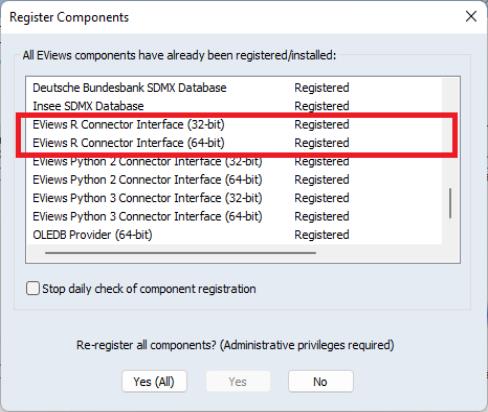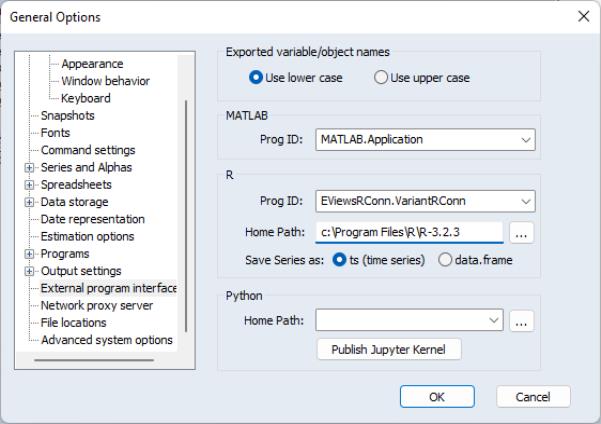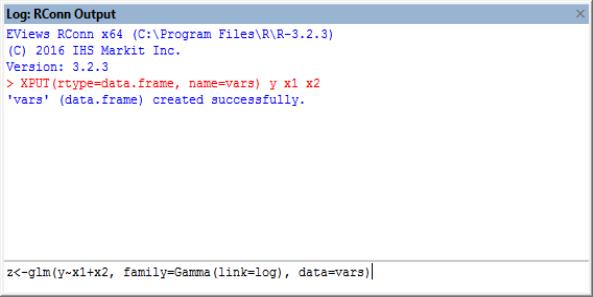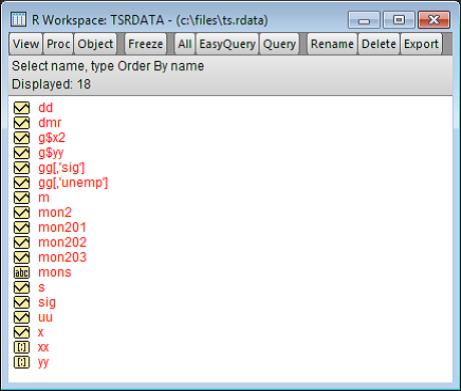EViews COM Automation Client Support (MATLAB, R, Python)
EViews offers COM Automation client support for select external application servers. Support is currently provided for three applications: MATLAB, R, and Python.
The client support includes a set of EViews functions for exporting EViews data to the external application, running commands and programs in the application, and importing data back into EViews. These functions provide easy access to the powerful programming languages of MATLAB, R, and Python to create programs and routines that perform tasks not currently implemented in EViews. The interface also offers access to the large library of statistical routines already written in the MATLAB, R, and Python languages.
There are nine EViews commands that control the use of external applications:
xclose,
xget,
xlog,
xopen,
xput,
xon,
xoff,
xpackage, and
xrun.
xopen and xclose are used to open and close a connection to the external application (MATLAB or R). xput and xget are used to send data to and from the external application. xrun is used to send a command to the external application, and, finally, xlog lets you show or hide an external application log window within EViews.
Using MATLAB®
To open a connection to MATLAB, simply use the xopen(type=m) command. EViews will then attempt to launch MATLAB on your computer. Note, your computer must have access to MATLAB, either through a local installation, or through a network. EViews has been tested with MATLAB release R2008a, although other versions may work as well.
Once a connection to MATLAB has been made,
xput may be used to pass data from EViews over to MATLAB. All numerical data is passed to MATLAB as a matrix. String data (in the form of an alpha series or svector) will be passed to a MATLAB char if each string contains the same number of characters. Otherwise the string data will be passed as a cell array. Series and group objects are always filtered by the current sample unless you specify an explicit sample in the
xput command.
Note that object names in EViews are not case sensitive. Unless otherwise specified, EViews objects that are passed into MATLAB using
xput will have the same name as the EViews objects that are being pushed, with the case determined by the case established for the COM connection (see
xopen).
xrun can be used to issue a single line command to MATLAB. You may, for example, use xrun to invert a matrix or run a program in MATLAB. If you wish to run multiple commands, each command must be entered with a separate xrun command. Commands should be surrounded in quotes.
xget can be used to fetch data from MATLAB into EViews. The “type=” option lets you specify the type of object that will be created in EViews. If no option is specified, MATLAB matrices will be brought in as EViews matrix objects, while chars and cell arrays will be brought in as svectors. If you use “type=series” or “type=alpha” to specify that the data is brought in as a series or an alpha series, EViews will create a series of workfile length, and either truncate the data, or pad with NAs, if the incoming matrix does not have the same number of rows as there are workfile observations.
The follow program offers a simple example using MATLAB to perform a least-squares regression (more complicated operations may be performed by using xrun to run a MATLAB program):
wfcreate u 100
series y=nrnd
series x1=nrnd
series x2=nrnd
group xs c x1 x2
xopen(type=m, case=lower)
xput xs
xput y
xrun "beta = inv(xs'*xs)*xs'*y"
xget beta
equation e1.ls y xs
show e1
show beta
xclose
The program first creates a new workfile, and then creates some series objects. The series called Y is the dependent variable, and the series X1 and X2 are the regressors (along with a constant). xopen is used to open a connection to MATLAB, and then xput is used to pass the dependent variable and the regressors over to MATLAB. Note that the names of the matrices and vectors will all be lower-cased in MATLAB since the connection was opened with the “case=lower” option.
xrun is used to create a vector in MATLAB, called “beta”, equal to the least squares coefficient, using the matrix algebra formula for LSQ. beta is brought back into EViews with the xget command, and then we estimate the same equation inside EViews and show the two results for comparison. Finally the connection to MATLAB is closed.
Using R
R is a GNU-project software environment for statistical computing and graphics. R is free software (under the terms of the GNU General Public License) that is readily available for download from the Official R Project website: http://www.r-project.org/ and other mirror sites.
To use the EViews external interface to R, you must have R installed on your Windows computer. Once installed, you may use the commands listed above to communicate with R from within EVIews.
EViews 14 supports R integration directly, eliminating the need for any third party software. Install both EViews 14 and R on the same computer and use normal EViews commands, such as XOPEN and XRUN.
Installing R
EViews was developed and tested with R version 3.2.3. You must have version 3.2.3 or newer installed on the machine running EViews.
If you do not currently have R installed, simply go to the following site and download the latest version:
Verifying EViews R Connector
Verify that the new EViews R Connector Interface components are properly registered by running the EViews command REGCOMPONENTS:
In the Register Components dialog, make sure that the EViews R Connector Interface objects have been properly registered. If not, click the button to re-register these components on your local machine, then re-run REGCOMPONENTS to verify the registration. Note: Registration of these components will require local administrator rights. If you do not have these admin rights, please contact your IT department for support.
Next, go to the External Program Interface dialog under the :
In COM ProgID group, make sure that EViewsRConn.VariantRConn is selected for R.
Next, if is blank, click the […] button and navigate to your local R installation. Select the version-specific R folder (e.g., “R-3.2.3”) under the parent R folder as your home directory.
Optionally, you can also select your as preference when pushing EViews series objects into R. If you select “ts (time series)”, series objects that have a compatible R ts frequency will be pushed as R ts objects. Otherwise, an R data.frame structure will be created instead.
Now we're ready to begin using R.
Opening a Connection to R
All external program interface methods must begin with a call to XOPEN:
XOPEN(type=r)
This will begin a new session of R and, by default, an associated RConn Output log window should appear. This log window will show any R commands we run and any output generated by R. You can also type R commands interactively into the RConn log window.
Now that we have an open connection to R, we can use the other 'X' methods to perform some actions.
Sending EViews Data to R
Now that we have an open connection to R, we can send EViews object(s) to R using the XPUT command:
XPUT(rtype=data.frame, name=vars) y x1 x2
Basic EViews object types such as series, alphas, matrices, vectors, and scalars can be pushed successfully to R. Depending on the EViews object type, an appropriate R object will be created when the data is sent. As our example shows, XPUT also supports grouping multiple series objects into a single R time series or R data.frame object.
Running an R Command
Now that we have some data in R, we can run R specific commands by using the XRUN command:
XRUN z<-glm(y~x1+x2, family=Gamma(link=log), data=vars)
You can also type this command directly into the bottom of the RConn log window (without XRUN):
XON and XOFF Commands
To run multiple R commands without having to specify XRUN on each line of an EViews program, you can use the XON and XOFF commands (introduced in EViews 10) to control external programming mode. Once you call XON, all program lines after that will be sent to R directly. Use XOFF (or XCLOSE) to turn this mode off.
XON 'Turn on external programming mode
z<-glm(y~x1+x2, family=Gamma(link=log), data=vars) summary(z)
XOFF 'Turn off external programming mode
Output Display
Note that our connector does not always automatically capture all of your R output. Consequently, you may find that using XRUN to issue a command that displays output in R may return only a subset of the usual output to your log window. In the most extreme case, you may see a simple "OK" message displayed in your log window. To instruct R to show all of the output, you should use enclose your command inside an explicit print statement in R. Thus, to display the contents of a matrix X, you must issue the command
XRUN print(X)
instead of the more natural
XRUN X
Retrieving R Data into EViews
To retrieve data back into EViews, we will use the XGET command:
XGET(name=beta, type=vector) z$coef
Closing the R Connection
Once we've completed our R operations, we can close our connection with a simple call to XCLOSE:
XCLOSE
Ability to Save EViews Workfile as RDATA Workspace File
EViews also has native RDATA workspace file compatibility.
This means you can save an EViews workfile (one page at a time) directly to a new RDATA workspace file:
wfsave(type=rdata) c:\files\tq.rdata
Each simple object (series, alpha, matrix, vector, and scalar) on the current workfile page will be converted to an appropriate R data structure and saved into the new RDATA file.
You can also open a pre-existing RDATA file as an EViews workfile, though because this operation can only open all R objects into a single workfile page, all the objects in the RDATA file must be the same frequency for this to work properly.
In cases where there are R objects with different frequencies, it would be better to treat the RDATA file as an EViews Database instead.
Open RDATA Workspace File as an EViews Database
In EViews 14, you can now open an RDATA workspace file as an EViews Database:
DBOPEN(type=rdata) c:\files\data.rdata
This will open the RDATA file in its own EViews database window. You can view all the R objects found in this database and individually FETCH the objects you want into your workfile:
Note: R data structures that could have multiple columns/elements (such as data.frame, list, and mts objects) are listed once per column/element with the appropriate R name.
As an EViews Database, you can use both FETCH and STORE to read and write data to the RDATA file and even link EViews series objects back to their source R structure to allow for simple data refreshes.
R Related Links
The Official R Project website: http://www.r-project.org/
Using Python
EViews allows you to use Python packages and code from within EViews to improve your workflow. With EViews, you can send EViews data into the Python environment, execute Python functions, and then retrieve data back into EViews with simple commands.
EViews supports Python 2 (version 2.7.15 or greater) and Python 3 (version 3.6.5 or greater).
The syntax for the Python related xopen options is:
XOPEN(p)
or
XOPEN(type=p)
We support the following Python data types:
list
tuple
dictionary
numpy.ndarray
pandas.series
pandas.dataframe
The last three lines require the prior installation of the numpy and the pandas Python packages.
The syntax for Python related xput commands is therefore:
xput(ptype=list|tuple|dictionary|ndarray|series|dataframe)




